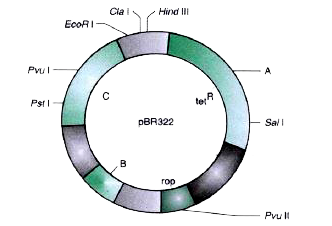Heterochoromatin is (a) darkly stained region (b) loosely packed chromatin (c) transcriptionally inactive
only (a)
only(a) and (b)
only (b) and (c)
only(a) and(c)
To solve the question regarding heterochromatin, we will analyze each option provided:
1. Understanding Heterochromatin:
- Heterochromatin is a type of chromatin found in the nucleus of eukaryotic cells. It is known for its dense and compact structure.
2. Evaluating Option (a):
- Darkly Stained Region: Heterochromatin appears darkly stained under a microscope due to its tightly packed nature. This is a characteristic feature of heterochromatin.
- Conclusion: This option is correct.
3. Evaluating Option (b):
- Loosely Packed Chromatin: Heterochromatin is not loosely packed; instead, it is highly condensed. Loosely packed chromatin refers to euchromatin, which is transcriptionally active.
- Conclusion: This option is incorrect.
4. Evaluating Option (c):
- Transcriptionally Inactive: Heterochromatin is generally transcriptionally inactive, meaning that the genes within this region are not expressed. This inactivity is due to its condensed structure, which makes it less accessible for transcription machinery.
- Conclusion: This option is correct.
5. Final Answer:
- Based on the evaluations, the correct answers are (a) darkly stained region and (c) transcriptionally inactive. Therefore, the best choices are A and C.
- Heterochromatin is a type of chromatin found in the nucleus of eukaryotic cells. It is known for its dense and compact structure.
- Darkly Stained Region: Heterochromatin appears darkly stained under a microscope due to its tightly packed nature. This is a characteristic feature of heterochromatin.
- Conclusion: This option is correct.
- Loosely Packed Chromatin: Heterochromatin is not loosely packed; instead, it is highly condensed. Loosely packed chromatin refers to euchromatin, which is transcriptionally active.
- Conclusion: This option is incorrect.
- Transcriptionally Inactive: Heterochromatin is generally transcriptionally inactive, meaning that the genes within this region are not expressed. This inactivity is due to its condensed structure, which makes it less accessible for transcription machinery.
- Conclusion: This option is correct.
- Based on the evaluations, the correct answers are (a) darkly stained region and (c) transcriptionally inactive. Therefore, the best choices are A and C.
Topper's Solved these Questions
Similar Questions
Knowledge Check
Read the following satements and select the correct option.
Loosely packed and light stained region of chromation are called as heterochromatin.
(ii) Densely packed and dark stained region of chromatin are called as euchromatin.
(iii) A typical nucleosome contains 200 bp of DNA helix.AStatements (i) and (ii) are true , but statement (iii) is false.BStatement (i) and (ii) are false, but statement (iii) is true.CStatement (ii) and (iii) are true , but statement (i) is false.DAll the statements are true.
The region of chromatin that is stained lightly is
View SolutionName the transcriptionally active region of chromatin in a nucleus.
View SolutionName the transcriptionally active region of chromatin in a nucleus.
View SolutionAssertion :- Euchromatin is said to be transcriptionally acitve chromatin.
Reason : Due to loose coilling of enchromatin RNA polymerase can easily move up on it.
View Solution[A]: Chromatid is one of a pair of replicated chromosomes found during the prophase and metaphase stages of mitosis and meiosis.
[R]: Chromatin is classified as euchromatin or heterochromatin on the basis of staining properties. Euchromatin is thought to be actively involved in transcription and, therefore, protein synthesis, while heterochromatin is inactive.
View SolutionGenetically inactive and higly condensed region with tighly packed DNA is
View SolutionName the regions marked A, B and C.

View Solution
